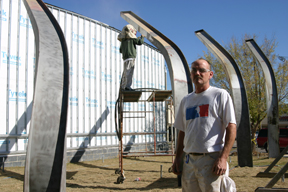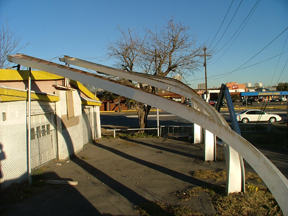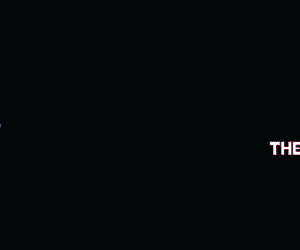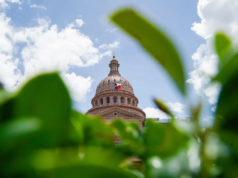Beams bent by the tornado will help mark the entrance to the Cultural District.
By JEFF PRINCE
Painting steel beams is nothing new for Jeff Trice, a commercial painter who’s done plenty of industrial jobs over the years. But painting a unique steel artwork in the city’s highest-profile spot – the museum district gateway – is a dream job for this 47-year-old Fort Worth native.
“I’ve never done anything like this,” he said while sandblasting rust from the row of curved steel beams just north of the intersection of University Drive, 7th Street, Camp Bowie Boulevard, and Bailey Avenue. “This has got to be one of the busiest corners around. I’m proud to have worked on this piece of art. When I drive by, I can tell people I painted it.”
The four beams weren’t originally art – they were supports for a billboard at the same location. But the tornado that cut a destructive swath through Fort Worth in 2000 bent the beams almost in half – and transformed them into an eloquent sculpture that symbolizes Mother Nature’s immense power and mankind’s perseverance. They now stand outside the new U.S. Post Office between University and Bailey, providing a startling welcome to motorists and museum visitors.
The unnamed artwork will get its official introduction early next year at a dedication. A photographic mural on the post office’s south wall, depicting a broad Texas horizon and an ominous storm cloud, will serve as a backdrop to the sculpture. The combined artworks, appropriately, will be accompanied by the postal service’s unofficial motto: “Neither snow, nor rain, nor heat, nor gloom of night stays these couriers from the swift completion of their appointed rounds.”
The tornado that hit Fort Worth on March 28, 2000, touched down on the near West Side at about 6:15 p.m., cutting through the Cultural District and the modest neighborhood of Linwood that sits immediately to the northeast of the University-Camp Bowie intersection. Many of Linwood’s small frame houses were destroyed and others heavily damaged. But the help that converged on the area after the storm actually inspired residents to get organized to save their neighborhood, whose street signs now carry “toppers” with the Linwood name and the image of a tornado.
The storm raced through the center of town, touching down again east of I-35. Rain, hail, and high winds devastated downtown and other parts of the inner city, killing five people, injuring many others, knocking down buildings, and causing an estimated $500 million in damages. Afterward, several downtown skyscrapers remained boarded up for years, becoming towering symbols of this city’s brush with nature. But those buildings were eventually renovated, though other smaller buildings had to be razed.
Now the most visible reminders of that tragedy are the billboard’s four girders, showing in vivid fashion the tornado’s direction and power. The billboard acted as a sail of sorts, catching the tornado’s force and doing the near-impossible – bending steel girders that weigh thousands of pounds.
For years, Al’s Trim Shop stood on the property and advertised its business on the billboard. The building sustained heavy tornado damage, and in 2003 the owner sold the property to the Museum Place developers, who tore down the structure. Original plans called for removing the damaged billboard girders as well, Museum Place consultant Phillip Poole said.
But Poole, Ed Bass, and others had grown fond of the bent steel survivors of the storm and supported an architect’s decision to include them in the post office’s design.
“The reason I wanted to keep it was that it truly epitomized the force of nature,” Poole said. “You could hardly design something to come out so soaring and beautiful.”
The sculpture looks like wheat bending over in a breeze, Poole said, an effect that’s difficult or impossible to create by hand, considering the steel beams are built to withstand immense pressure.
“Those are wide-flange beams; it takes an incredible force to bend one of them,” he said. “If you tried to bend one of these, you would have to send them to Germany to get them bent like [sculptor] Richard Serra did.”
Serra’s sculpture, “Vortex,” installed outside the nearby Modern Art Museum of Fort Worth, was created from massive pieces of twisted metal wrought by a specialty company in Germany at a reported cost of more than $3 million, including the cost for shipping them across the Atlantic. The Burnett Foundation provided the money.
The Cultural District’s billboard sculpture is a steal by comparison.
“It’s probably the least expensive piece we’ll ever get in this town,” local sculptor Deran Wright said with a chuckle.
He wasn’t aware of any similar piece of public art fashioned by a tornado, and he was glad to see it retained, although he prefers to call it an artifact rather than sculpture.
“I wouldn’t call it a sculpture because it wasn’t designed by anybody,” he said. “It’s definitely interesting and certainly looks like somebody should have thought of it.”
Others, such as Modern Art Museum chief curator Michael Auping, consider it more historical marker than sculpture.
“I’m not sure it’s art, but I think it’s really neat,” he said. “It’s nice they did keep that as a memory of what happened.”
The trim shop property became part of the Museum Place development, a $200 million, 11-acre, mixed-use development currently under construction. The centerpiece structure is One Museum Place, an eight-story building combining dwellings, restaurants, and shops. Directly across Bailey Avenue is the sculpture, part of the view for the future condo residents, occupants of toney corner offices, and museum visitors.
Such a high-profile spot draws plenty of attention from museum board members and other movers and shakers, who are trying to make the district a showplace. They, too, saw the bent steel beams as a perfect fit for public art.
“Everybody recognized there was just something incredibly unique about it,” Museum Place chief financial officer H. Reece Pettigrew said. “We decided to salvage it.”
Developers made a deal to move the local branch post office from its old spot between West 7th and Camp Bowie to the prominent corner of the big intersection. The billboard beams were moved about 50 feet from their original location to accommodate the new building. Museum Place officials sought funding from arts foundations to help pay for a design for the new post office, to include the large mural.
Pettigrew wouldn’t name donors, saying they will be revealed during next year’s dedication. However, Amon G. Carter Foundation executive vice president John Robinson said his group contributed $85,000 to “enhance the design” so that it “would be more complimentary to the museum district area.” After all, a post office’s plain back wall wasn’t what cultural district officials had in mind for their gateway. The nonprofit foundation has provided millions of dollars in grants over the years to help beautify Fort Worth. “We were approached about being one of a number of community participants to make the post office more attractive,” he said.
The foundation’s gift didn’t give it architectural control, but Robinson was pleased that the bent billboard supports were included. “That’s part of the history of Fort Worth,” he said.
The artwork probably won’t be named, although a plaque describing its origin will be revealed at the dedication, Pettigrew said.
“We’re just going to let it stand for itself,” he said. “So many people recognize it and know it’s there and what it was.”











